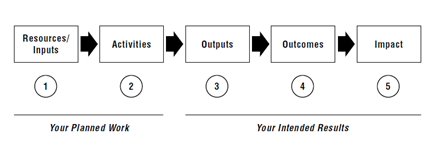Home » Session 3: What are the expected changes?
Sustainability Project Impact Assessment
Session 3: What are the expected changes?
A logic model is introduced here as it is a useful tool for answering the above question. It offers a framework to systematically unravel the relationships between the planned work in a programme and the intended results. This is considered since the first step of the process as it plays an important role in programme design and planning as well as programme management and evaluation. Undergoing the process of developing the logic model prompts one to reflect on the theory and assumptions underlying the cause-effect relationships between the programme design and its objectives (Kellogg Foundation, 2004). Step by step, the logic model guides the identification of outcomes based on the programme activities and anticipate ways to measure them, providing a clear roadmap for programme evaluation. Effective programme evaluation provides the basis for continue programme improvement and learning opportunities as knowledge can be shared on what works and why (Kellogg Foundation, 2004). The diagram below offers a visual representation of the sequence of components which should be considered to decipher the linkage between the activities and expected achievements.

Source: Kellogg Foundation, 2004: 1
A description of the five components of the logic model
- Resources available for programme implementation can include human, financial, organisational and community resources.
- Programme activities are the interventions that are used with the intension of bringing about the expected changes or results. These usually include events, actions, implementation of tools or technologies.
- Outputs is the first part of the programme’s intended results. These are the direct products of the programme activities, for example, services delivered by the programme.
- Outcomes are the changes caused by the outputs, which may include changes in behaviour, knowledge and skills.
- Impact refers to the extended changes which could potentially be caused by the outcomes. These changes tend to occur in a longer time frame and are experienced at a higher level, i.e. in the wider community.

To demonstrate the application of the logic model, an example will be provided based on the HSBC Rural Sustainability Programme (‘Programme’), which is initiated by the Centre for Civil Society and Governance at the University of Hong Kong. This Programme is aimed at finding a sustainable path for rural development and promoting rural-urban symbiosis. This is done through several key strategies such as incubating socio-economic models, mobilising actions of the local community to preserve ecological and cultural assets, foster human-nature coexistence and co-prosperity. For the purpose of conducting a systematic and efficient impact assessment, each component of this Programme is matched with a specific core dimension of sustainability. Collectively, this Programme contributes towards all five core dimensions of sustainability.
For illustration purposes, one of the Programme’s component - the Rural in Action Start-up scheme (‘Start-up scheme’) has been selected as the focus of this e-case, in order to take readers through the three key steps of assessment. The Start-up scheme was set up to incubate a total of 10 start-ups with the aim of fostering rural-urban interactions and collaboration for the sustainable development of rural areas. A grant of up to HKD200,000 was awarded to each project alongside other kinds of support such as training opportunities, community networks, promotion and publicity and professional advice on rural affairs.

The report is available upon request (by sending the request to ruralsd@hku.hk)
The focus of the Start-up scheme lies in innovation and resilience which best matches the Sustainability Core Principle of “Precaution and Adaptation”. Hence the indicators under Core dimension 4 will be applied to assess the impact of this scheme.

Despite introducing the logic model as one of the first steps in the process of programme planning and design, revisiting and revising it is crucial throughout the programme. During programme implementation, the logic model offers reminders on where the energies and resources should be focused on to achieve the intended results, as well as offering important guidance on identifying what to measure and what kind of data to collect. Just as programme activities and even strategies need to be adjusted over time, either due to changes in circumstances or after gaining a better understanding of the problems/issues or context, logic models too should be regularly reviewed and amended as needed. Therefore, a logic model should be considered as a work in progress, a working draft that can be refined as the programme develops (Kellogg Foundation, 2004).
References
Kellogg Foundation (2004) Logic Model Development Guide, W.K. Kellogg Foundation, USA. Retrieved from https://hmstrust.org.au/wp-content/uploads/2018/08/LogicModel-Kellog-Fdn.pdf
Kellogg Foundation (2017) The Step-by-Step Guide to EVALUATION: How to Become Savvy Evaluation Consumers, W.K. Kellogg Foundation, USA. Retrieved from https://www.wkkf.org/resource-directory/resource/2010/w-k-kellogg-foundation-evaluation-handbook
Further resources
HSBC Rural Sustainability Programme: https://ccsg.hku.hk/ruralsd/
Rural in action start-up scheme: https://ccsg.hku.hk/ruralsd/en/pages/academy/start-ups-incubation/
Sustainability Impact Assessment: Framework and Report on HSBC Rural Sustainability: The report is available upon request (by sending the request to ruralsd@hku.hk)
Theory of Change: A Practical Tool for Action, Results and Learning, by J. Reisman and A. Gienapp, published by Organizational Research Services in 2004. Available at http://www.aecf.org/upload/publicationfiles/cc2977k440.pdf
Continue to “Session 4: What to measure?”
© 2022 Centre for Civil Society and Governance at The University of Hong Kong
Except where otherwise noted, contents of this e-case is licensed under a Creative Commons Attribution-NonCommercial-ShareAlike 4.0 License.
![]()


